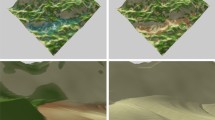Abstract
Purpose
Vertical-flow constructed wetland (VFCW) is a promising technique for wastewater treatment comparable to conventional wastewater treatment plants. The physical, chemical, and biological processes and interactions in a VFCW are highly coupled with water movement, and thus the performance of a VFCW to remove contaminants hinges on a better understanding of its water dynamics. The aim of this study was to develop a model for estimating water dynamics in an artificial VFCW with a growing plant system.
Materials and methods
The model was developed using the commercial available package STELLA (Structural Thinking, Experiential Learning Laboratory with Animation) in conjunction with our greenhouse experimental data. The water dynamics included in the model are: (1) application of wastewater to the VFCW, (2) evaporation and transpiration, (3) formation of water column due to the surface ponding, (4) uptake of water by roots, (5) clogging of substrate pores by wastewater, and (6) flow of water through the VFCW under variably saturated conditions. The resulted model was applied to estimate water dynamics in an artificial VFCW (i.e., a large cylindrical column) under a wetting-to-drying ratio of 1:3, i.e., recharging the column for 8 h followed by drying the column for 24 h.
Results and discussion
A simulation scenario was performed to investigate the daily water dynamics in the presence of the Cyperus alternifolius species under a wetting-to-drying ratio of 1:3. Results showed that surface water ponding occurred periodically and increased with time due to a decrease in the column infiltration rate resulting from the pore clogging by the wastewater (with a suspended solid content of 99 mg/L). Root water uptake and leaf water transpiration showed a typical diurnal pattern, i.e., increased during the day and decreased to near-zero at night as well as increased as the C. alternifolius grew. A 15% decrease in porosity due to the pore clogging resulting in 65% decrease in wastewater inflow rate for the simulation conditions used in this study.
Conclusions
A good agreement was obtained between the model predictions and the greenhouse measurements during the model calibration. The model was quite successfully applied to estimate water dynamics in an artificial VFCW with a growing C. alternifolius wetland plant. Further study is warranted to extend the model for estimation of coupled water movement and contaminant removal in the VFCWs.










Similar content being viewed by others
References
Aassine S, El Jai MC (2002) Vegetation dynamics modelling: a method for coupling local and space dynamics. Ecol Moldel 154:237–249
Cooper P (1999) A review of the design and performance of vertical-flow and hybrid reed bed treatment systems. Water Sci Technol 40(3):1–9
Costanza R, Voinov A, Boumans R, Maxwell T, Villa F, Voinov H, Wainger L (2002) Integrated ecological economic modeling of the Patuxent river watershed, Maryland. Ecol Monographs 72:203–231
Cui LH, Ouyang Y, Chen Y, Zhu XZ, Zhu WL (2009) Removal of total nitrogen by Cyperus alternifolius from wastewaters in simulated vertical-flow constructed wetlands. Ecol Eng 35:1271–1274
Fu WJ, Tang Y (2005) The roles of plants in constructed wetlands and species selection. Sichuan Environ 24:45–49
Groudeva VI, Groudev SN, Doycheva AS (2001) Bioremediation of waters contaminated with crude oil and toxic heavy metal. Int Miner Process 62:293–299
Hannon B, Ruth M (1994) Dynamic modeling. Springer-Verlag, New York
Hillel D (1982) Introduction to soil physics. Academic, New York
Isee System (2006) Technical document for the iThink and STELLA software. Available at: http://www.iseesystems.com
Kadlec RH, Knight RL, Vymazal J, Brix H, Cooper P, Haberl R (eds) (2000) Constructed wetlands for pollution control—processes, performance, design and operation. IWA Scientific and Technical Rep. 8. IWA Publ., London
Langergraber G, Haberl R, Laber J, Pressl A (2003) Evaluation of substrate clogging processes in vertical flow constructed wetlands. Water Sci Technol 48:25–34
Langergraber G, Šimùnek J (2005) Modeling variably saturated water flow and multicomponent reactive transport in constructed wetlands. Vadoze Zone J 4:924–38
Liao XD, Luo SM et al (2005) Comparison of nutrient removal ability between Cyperus alternifolius and Vetiveria zizanioides in constructed wetlands. Chinese J Appl Ecol 16:156–160
Martin JF, Reddy KR (1997) Interaction and spatial distribution of wetland nitrogen processes. Ecol Model 105:1–21
Mullins JA, Carsel RF, Scarbrough JE, Ivery AM (1993) PRZM-2, a model for predicting pesticides fate in the crop root and unsaturated soil zones: User manual for release 2.0, U.S. EPA, Athens, GA.
Nobel PS (1983) Biophysical plant physiology and ecology. Freeman and Co, San Francisco
Ouyang Y (2008) Modeling the mechanisms for uptake and translocation of dioxane in a soil–plant ecosystem with STELLA. J Contam Hydrol 95:17–29
Ouyang Y, Zhang JE, Lin D, Liu GD (2009) A STELLA model for the estimation of atrazine runoff, leaching, adsorption, and degradation from an agricultural land. J Soils Sediments 10(2):263–271
Peterson SB, Teal JM (1996) The role of plants in ecologically engineered wastewater treatment systems. Ecol Eng 6:137–148
Schwager A, Boller M (1997) Transport phenomena in intermittent filters. Water Sci Technol 35:13–20
Vymazal J (2005) Horizontal sub-surface flow and hybrid constructed wetlands systems for wastewater treatment. Ecol Eng 25:478–490
Vymazal J (2007) Removal of nutrients in various types of constructed wetlands. Sci Total Environ 380:48–65
Wynn MT, Liehr SK (2001) Development of a constructed subsurface-flow wetland simulation model. Ecol Eng 16:519–536
Acknowledgments
The study was supported by the Natural Science Foundation of China (No. 30828005 and No. 40871110).
Author information
Authors and Affiliations
Corresponding author
Additional information
Responsible editor: Gilbert Sigua
Rights and permissions
About this article
Cite this article
Ouyang, Y., Luo, S.M., Cui, L.H. et al. Estimation of water dynamics in a vertical-flow constructed wetland with a growing plant species. J Soils Sediments 10, 1219–1228 (2010). https://doi.org/10.1007/s11368-010-0240-4
Received:
Accepted:
Published:
Issue Date:
DOI: https://doi.org/10.1007/s11368-010-0240-4




